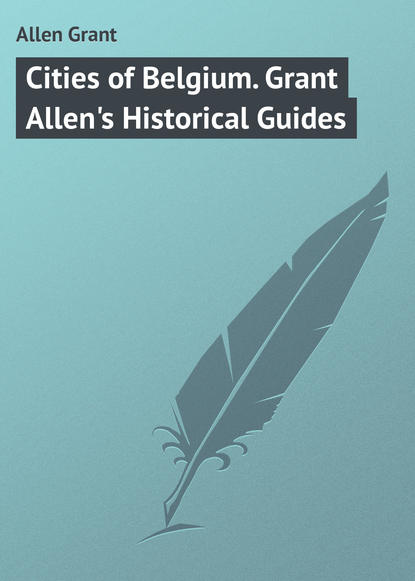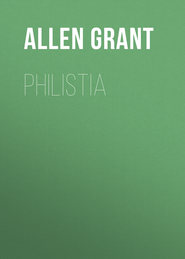По всем вопросам обращайтесь на: info@litportal.ru
(©) 2003-2024.
✖
Cities of Belgium. Grant Allen's Historical Guides
Настройки чтения
Размер шрифта
Высота строк
Поля
537. Admirable unknown portrait. These little works again need no description, but close study.
Above them, 244. Quentin Matsys (?). The Misers, one of the best known of this favourite subject.
Then, another frame of miniatures.
517, 518. Unknown Flemish 14th century Madonna and Child, with donor and wife.
541, 522. Tolerable portraits.
545. Fine portrait, of the Spanish period.
410. **Van Eyck’s celebrated unfinished St. Barbara, holding her palm of martyrdom, and with her tower in the background. It should be closely studied, both as an indication of the master’s method, and as a contemporary drawing illustrating the modes of mediæval building. For a careful criticism, see Conway.
Above these, Engelbrechtsen, 130. St. Hubert, attired as bishop, bearing his crozier and hunting horn, and with the stag beside him, with the crucifix between its horns.
127. The same. St. Leonard releasing prisoners.
Then, another case of good small pictures.
3. A Fra Angelico. Interesting in the midst of these Flemish pictures. St. Romuald reproaching the Emperor Otho III. for the murder of Crescentius.
32. Petrus Christus (?). A donor and his patron, St. Jerome.
64. A landscape by Patinir.
536. A Baptism of Christ, where note the conventional arrangement and the angel with the robe.
561. Triptych. Madonna and Child. St. Christopher, and St. George. Harsh and angular.
548. Mater Dolorosa, transpierced by the sword.
535. Good Flemish Madonna with angels.
207. Lucas of Leyden: Adoration of the Magi. You can now note for yourself the ox, ass, Joseph, position, age, and complexion of Kings, etc.
29. Attributed (doubtfully) to Dierick Bouts: St. Christopher wading, with the Infant Christ. In the background, the hermit and lantern. (See Mrs. Jameson.)
176. Giotto: A St. Paul with the sword. Characteristic of early Florentine work.
257, 258, 259, 260. Simone Martini of Siena: Four panels. Extreme ends, **Annunciation, closely resembling the figures in the Ufizzi at Florence: Annunciations are often thus divided into two portions. Centre, Crucifixion and Descent from the Cross. These exquisitely finished little works are full of the tender and delicate spirit of the early Sienese School. In the Crucifixion, notice particularly the Magdalen, and St. Longinus piercing the side of Christ. Our Lady in the Annunciation has the fretful down-drawn mouth inherited by early Italian art from its Byzantine teachers.
177. Giotto: St. Nicolas of Myra with the three golden balls, protecting a donor.
Above are three good portraits by Van Orley, and other works which need no description.
On easels at the end, 255. Attributed to Memling: **Exquisite Madonna and Child in a church. Our Lady, arrayed as Queen of Heaven, with a pot of lilies before her, stands in the nave of a lovely early Gothic cathedral, with a later Decorated apse, and admirable rood-screen. Every detail of the tiles, the crown, the screen, and the robe, as well as Our Lady’s hair and hands, should be closely looked into. This is one of the loveliest pictures here. It is a very reduced copy from one by Jan van Eyck at Berlin: the church is that of the Abbey of the Dunes near Furnes. Its attribution to Memling has been disputed: Conway believes it to be by a follower. In any case, it is lovely.
256. **Companion panel, of the donor, a Cistercian Abbot of the Dunes, in a sumptuous room, half bed-chamber, half study, with a beautiful fireplace and fire. He kneels at his prayers, having deposited his mitre on a cushion beside him, and laid his crozier comfortably by the fireplace. Creature comforts are not neglected on the side-board. Here also every decorative detail should be closely examined. These are two of the very finest works of the School of Memling. Probably the Abbot admired Jan van Eyck’s Madonna, painted for a predecessor, and asked for a copy, with himself in adoration on the other wing of the diptych.
At the back, on a revolving pivot,
530, 531. Christ blessing, and a Cistercian Canon in adoration. As usual, the outer panels are less brilliant in colouring than the inner. Notice the Alpha and Omega and the P. and F. (for Pater and Filius) on the curtain behind the Saviour. These works are by an inferior hand.
The other easel has a fine (208, 209, 210) *Lucas van Leyden: Adoration of the Magi, with fantastic elongated figures. Note the ruined temple. The other features will now be familiar. Lucas’s treatment is peculiar. L., St. George and the Dragon. The saint has broken his lance and attacks the fearsome beast with his sword. In the background, the Princess Cleodolind and landscape. R., The donor, in a rich furred robe, and behind him, St. Margaret with her dragon. At the back, 181, wings, by the same, with a peculiar Annunciation (the wings being open, reversed in order). Between them has been unwisely inserted an Ecce Homo by Gossaert.
Now, go straight through Rooms H, F, and E, to three rooms en suite, the last of which is
Room A,
containing the Transitional Pictures. (It is usual to skip these insipid works of the intermediate age, and to jump at once from the School of Van Eyck to the School of Rubens – I think unwisely – for Rubens himself can only properly be appreciated as the product of an evolution, by the light of the two main influences which affected him – his Flemish masters, and his Italian models, Veronese and Giulio Romano.) Begin at the far end, near the lettered doorway, and note throughout the effort to imitate Italian art; the endeavour at classical knowledge; and the curious jumble of Flemish and Tuscan ideas. But the Flemish skill in portraiture still continues.
698. Good portrait of Giles van Schoonbeke, by P. Pourbus.
Next to it, 103, Martin De Vos, the Elder: St. Anthony the Abbot, accompanied by his pig and bell, and his usual tempters, burying the body of St. Paul the Hermit, whose grave two lions are digging. To the R., hideous Flemish devils, grotesquely horrible. Above, phases of the Temptation of St. Anthony.
372. Michael Coxcie: Martyrdom of St. George – one of his tortures. Good transitional work, inspired by Italian feeling.
72. M. De Vos: Triptych, painted for the altar of the Guild of Crossbowmen in the Cathedral. Centre, Triumph of the risen Christ. In the foreground, St. Peter (keys), and St. Paul (sword), with open pages of their writings. L., St. George, patron of the Crossbowmen, with his banner and armour; R., St. Agnes with her lamb. Left panel, Baptism of Constantine by St. Sylvester. Right panel, Constantine ordering the erection of the Church of St. George at Constantinople. In the sky, the apparition of Our Lady to the Emperor. A gigantic work, recalling the later Italian Renaissance, especially the Schools of Bronzino and Giulio Romano.
374. Michael Coxcie: Martyrdom of St. George; the other wing of the same triptych in honour of St. George as 372; central portion lost.
89. M. De Vos: St. Conrad of Ascoli, a Franciscan friar, in devout contemplation of the founder of his Order, St. Francis, receiving the Stigmata. Around it, small scenes from the life of St. Conrad, unimportant. Below, Devotion at the tomb of St. Conrad: royal personages praying, offerings of rich images, and the sick healed by his relics. A curious picture of frank corpse-worship.
699. Good portrait by Pourbus.
576. Triptych, unknown. St. Eligius of Noyon (St. Éloy), one of the apostles of Brabant, preaching to a congregation really composed of good local portraits. (A pious way of having oneself painted.) R. and L., St. Eligius feeding prisoners, and St. Eligius healing the sick.
741. Another of Bernard van Orley’s General Resurrections, the type of which will now be familiar to you. In the centre, strangely introduced group of portraits of the donors, engaged in burying a friend, whose memory this triptych was doubtless intended to commemorate. On either wing, the six works of Mercy (the seventh, burial, is in the main picture).
77. Good transitional triptych, by M. De Vos, for the Guild of Leather-dressers. Centre, The Incredulity of St. Thomas. On the wings, Scenes from the life of the Baptist. L., Baptism of Christ; where note the persistence of the little symbolical Jordan, with angels almost inconspicuous. R., The Decollation of St. John. Salome receiving his head in a charger. In the background, Herodias.
371. Coxcie the Younger: Martyrdom of St. Sebastian, patron saint of Bowmen, from their altar in the Cathedral. An attempt to be very Italian. The wings of this triptych are by Francken. L., St. Sebastian exhorting Marcus and Marcellinus to go to martyrdom. R., St. Sebastian miraculously healing the dumb woman, with portrait spectators, in dress of the period, deeply interested.
Now go on into
Room B,
(unlettered, the centre of the three). It contains works of an earlier period.
The left wall is entirely occupied by three large panels of a fine old Flemish 15th century picture, attributed to Memling (and apparently accepted as his by Lafenestre), representing *Christ Enthroned, with orb and cross, surrounded by choirs of angels; those in the central panel singing; the others, playing various musical instruments. This is a beautiful work, but less pleasing than those of the same school on a smaller scale. It has been recently bought from the monastery of Najera in Spain. It was intended, I think, to be seen at a height, probably on an organ-loft, and loses by being placed so near the eye of the spectator.
The opposite wall, R., is occupied by 245, Quentin Matsys’s masterpiece, the triptych of **the Entombment, painted for the altar of the Guild of Cabinet-makers. The colouring is much more pleasing than in the Family of St. Anne at Brussels. Central panel, The Entombment. Nicodemus supports the emaciated body of the dead Saviour, while Joseph of Arimathea wipes the marks of the crown of thorns from his head. The worn body itself, with a face of pathetic suffering, lies on the usual white sheet in the foreground. At the foot, Mary Magdalen, with her pot of ointment and long fair hair, strokes the body tenderly. In the centre is the fainting Madonna, supported, as always, by St. John, in his red robe. Behind are the three Maries. The usual attendant (a ruffianly Fleming, in a queer turban-like cap) holds the crown of thorns. At the back, preparations for the actual placing in the sepulchre. In the background, Calvary.
The wings have scenes from the lives of the two St. Johns. L., The daughter of Herodias, a very mincing young lady, in a gorgeous dress, brings the head of St. John the Baptist on a charger to her mother and a fiercely-bearded Herod. The queen appears to be about to carve it. Above, a gallery of minstrels. Admirable drapery and accessories. The R. wing has the so-called Martyrdom of St. John the Evangelist, in the cauldron of boiling oil, with a delightful boy spectator looking on in a tree. The Emperor Domitian (older than history), on a white horse, behind. Flemish varlets stir the fire lustily. This noble work originally decorated the altar in the Chapel of the Menuisiers of Antwerp in the Cathedral.
On easels, 649, Claeissens: Triptych of the Crucifixion, with the Way to Calvary and the Resurrection. Elongated, attenuated figures.
680. Giles Mostaert (the elder): Singular complex picture, painted for the Hospital of Antwerp; representing, above, The General Resurrection: Christ enthroned between Our Lady and St. John-Baptist. Beneath, naked souls rising from the tomb. To the L., St. Peter welcomes the just at the gate of the Celestial City. To the R., devils drive the wicked into the gaping jaws of Hell. Beneath, the courses that lead to either end: the Seven Works of Mercy, inspired by the Redeemer, and the Seven Deadly Sins, suggested by devils. I will leave you to identify them (it is easy).











